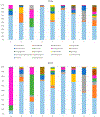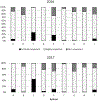Antimicrobial use in wean to market pigs in the United States assessed via voluntary sharing of proprietary data
- PMID: 33201609
- PMCID: PMC11465207
- DOI: 10.1111/zph.12760
Antimicrobial use in wean to market pigs in the United States assessed via voluntary sharing of proprietary data
Abstract
Data on antimicrobial use were collected for the 2016 and 2017 calendar years from swine producers in the United States. Nine large systems, collectively producing over 20 million market pigs annually, voluntarily provided data to advance understanding of antimicrobial use in the industry and to support antimicrobial stewardship initiatives. The scope of the study was limited to growing pigs, and the granularity of data varied across the systems. Data were summarized both qualitatively and quantitatively by antimicrobial class, active ingredient and route of administration (injection, water and feed). Data on the purpose of administration, doses and durations of administration were not available, but some information was provided by the responsible veterinarians. Aggregate data were similar both qualitatively and quantitatively in 2016 and 2017, although marked changes between years were evident within systems for some antimicrobials. Antimicrobial use (by weight) was dominated by the tetracycline class (approximately 60% of total use). Antimicrobials in classes categorized as critically important constituted 4.5% and 5.3% of total use in 2016 and 2017, respectively. In both years, fluoroquinolone (0.23%, 0.46%) and 3rd generation cephalosporin (0.15%, 0.11%) use collectively accounted for <1% of total use. Administration was predominantly oral in feed and water, and injection comprised approximately 2% of use overall, but around 12% for critically important antimicrobials. There was considerable variability among systems in patterns of antimicrobial use. This pilot project demonstrates the feasibility of acquiring antimicrobial use data via voluntary sharing. It is currently being expanded among larger swine production systems, and further efforts to enable confidential data sharing and benchmarking for smaller producers are being pursued by the swine industry. Recognized biases in the data caution against over-interpretation of these data as an index of national use.
Keywords: antimicrobial use; growing pigs; resistance; stewardship.
© 2020 The Authors. Zoonoses and Public Health published by Wiley-VCH GmbH.
Conflict of interest statement
CONFLICT OF INTEREST
The authors have no conflicts of interest to declare.
Figures




Similar articles
-
Estimates of on-farm antimicrobial usage in turkey production in the United States, 2013-2017.Zoonoses Public Health. 2020 Nov;67 Suppl 1:36-50. doi: 10.1111/zph.12763. Zoonoses Public Health. 2020. PMID: 33201604
-
Estimates of on-farm antimicrobial usage in broiler chicken production in the United States, 2013-2017.Zoonoses Public Health. 2020 Nov;67 Suppl 1:22-35. doi: 10.1111/zph.12764. Zoonoses Public Health. 2020. PMID: 33201602
-
Use estimates of in-feed antimicrobials in swine production in the United States.Foodborne Pathog Dis. 2012 Mar;9(3):272-9. doi: 10.1089/fpd.2011.0983. Epub 2012 Feb 10. Foodborne Pathog Dis. 2012. PMID: 22324295
-
Antimicrobial Resistance: a One Health Perspective.Microbiol Spectr. 2018 Mar;6(2):10.1128/microbiolspec.arba-0009-2017. doi: 10.1128/microbiolspec.ARBA-0009-2017. Microbiol Spectr. 2018. PMID: 29600770 Free PMC article. Review.
-
Antimicrobial use in swine production and its effect on the swine gut microbiota and antimicrobial resistance.Can J Microbiol. 2015 Nov;61(11):785-98. doi: 10.1139/cjm-2015-0239. Epub 2015 Aug 20. Can J Microbiol. 2015. PMID: 26414105 Review.
Cited by
-
The impacts of viral infection and subsequent antimicrobials on the microbiome-resistome of growing pigs.Microbiome. 2022 Aug 4;10(1):118. doi: 10.1186/s40168-022-01312-0. Microbiome. 2022. PMID: 35922873 Free PMC article.
-
Surveillance of antimicrobial resistance in veterinary medicine in the United States: Current efforts, challenges, and opportunities.Front Vet Sci. 2022 Dec 20;9:1068406. doi: 10.3389/fvets.2022.1068406. eCollection 2022. Front Vet Sci. 2022. PMID: 36605768 Free PMC article. Review.
-
Antimicrobial use in 20 U.S. beef feedyards: 2018-2019.Front Vet Sci. 2023 Mar 27;10:1056362. doi: 10.3389/fvets.2023.1056362. eCollection 2023. Front Vet Sci. 2023. PMID: 37051510 Free PMC article.
-
Assessment of a program for monitoring antimicrobial purchase and resistance in Escherichia coli and Salmonella enterica on pig farms in the Midwestern United States from May 2020 through October 2023.Front Vet Sci. 2025 Jul 25;12:1586008. doi: 10.3389/fvets.2025.1586008. eCollection 2025. Front Vet Sci. 2025. PMID: 40786982 Free PMC article.
-
Trends in Antimicrobial Usage on Swiss Pig Farms from 2018 to 2021: Based on an Electronic Treatment Journal.Antibiotics (Basel). 2024 Sep 2;13(9):831. doi: 10.3390/antibiotics13090831. Antibiotics (Basel). 2024. PMID: 39335005 Free PMC article.
References
-
- Anderson M, Clift C, Schulze K, Sagan A, Nahrgang S, Ait Ouakrim D, & Mossialos E (2019). Averting the AMR crisis: What are the avenues for policy action for countries in Europe? Copenhagen, Denmark: European Observatory on Health Systems and Policies. https://europepmc.org/article/med/31287637 - PubMed
Publication types
MeSH terms
Substances
Grants and funding
LinkOut - more resources
Full Text Sources
Medical

